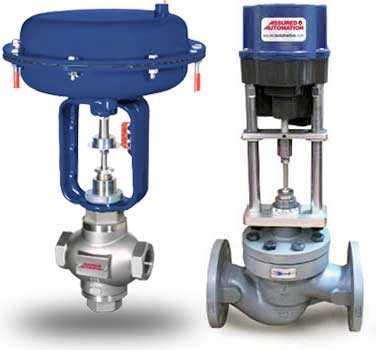Optimizing System Control with High-Performance Control Valves
Optimizing System Control with High-Performance Control Valves
Blog Article
Achieve Seamless Assimilation and Control With Top Quality Building Automation Controls
In the world of contemporary building monitoring, the value of quality building automation controls can not be overemphasized. Embracing top quality building automation controls is not just an issue of comfort however a calculated necessary for organizations aiming to enhance their facilities' performance and sustainability.

Evolution of Structure Automation Controls
Throughout the previous few decades, the evolution of constructing automation controls has significantly changed the way buildings are managed and run. Initially, developing automation systems mostly concentrated on fundamental features such as controlling home heating, air, and air flow conditioning (A/C) systems. However, as technology advanced, these controls have actually become a lot more advanced, enabling a wider variety of structure systems to be integrated and taken care of centrally.
The development of building automation controls has actually seen a change in the direction of even more smart systems that can adjust to transforming problems in real-time. This versatility is critical for optimizing energy performance and making sure occupant convenience. In addition, contemporary structure automation controls now provide attributes such as predictive upkeep, remote surveillance, and data analytics, enabling facility managers to make data-driven choices to improve structure efficiency.

Advantages of Top Quality Integration
The advancement in building automation regulates in the direction of more intelligent systems has actually emphasized the significant advantages of quality integration in enhancing structure operations and improving total performance. This central control additionally gives far better exposure and understandings right into building performance, allowing proactive upkeep and optimization approaches. Generally, the benefits of high quality combination in building automation controls are indisputable, supplying enhanced efficiency, comfort, and operational effectiveness.
Enhanced User Experience and Availability
Enhancing individual interaction with structure automation regulates with instinctive layout and improved availability raises the total experience for passengers and facility supervisors alike. By concentrating on user experience, constructing automation systems can become a lot more straightforward and reliable. User-friendly interfaces, clear navigating, and personalized setups encourage users to communicate with the controls quickly and effectively.
Ease of access attributes play a critical duty in ensuring that all individuals, including those with handicaps, can utilize the structure automation controls with convenience. Integrating features such as voice commands, responsive switches, and color-contrasted displays can website here improve ease of access and make the controls a lot more inclusive.
Moreover, boosted user experience causes higher customer contentment, enhanced performance, and far better decision-making. Owners can readjust ecological setups according to their choices, while facility supervisors can efficiently keep track of and take care of structure systems - control valves. Overall, prioritizing user experience and access in building automation controls adds to a much more seamless and efficient building atmosphere for all stakeholders entailed
Sustainable Practices Through Automation

Furthermore, automation can facilitate the combination of renewable resource resources such as solar panels or wind generators into building procedures. By instantly changing energy usage based upon the accessibility of renewable energy, buildings can additionally reduce their dependence on non-renewable resources. This smooth assimilation of sustainable techniques not only benefits the atmosphere yet additionally boosts the overall operational effectiveness and cost-effectiveness of the building. Via automation, structures can line up with modern-day sustainability goals and add to a greener future.
Future Trends in Structure Control Equipment
In expectancy of advancing innovations and developing sustainability methods, the trajectory of building control systems is positioned to welcome transformative approaches and cutting-edge options. One noticeable pattern forming the future of structure control systems is the raised combination of Expert system (AI) and artificial intelligence. These innovations make it possible for buildings to adapt in real-time to changing problems, optimizing power intake and improving comfort for owners. Furthermore, the Net of Points i thought about this (IoT) is reinventing building control systems by attaching sensors and devices to improve procedures and enhance effectiveness.
An additional vital pattern is the go right here focus on cybersecurity actions to shield versus prospective dangers to building automation systems. As buildings come to be a lot more interconnected, making certain robust cybersecurity procedures will certainly be important to secure sensitive information and protect against unauthorized access.
Additionally, the shift in the direction of cloud-based systems is gaining energy, permitting streamlined control and remote access to building systems. This assists in easier surveillance, maintenance, and updates, boosting the total performance and versatility of structure control systems. As innovation continues to breakthrough, these patterns are expected to form the future landscape of structure automation controls, driving innovation and sustainability in the built environment.
Final Thought
To conclude, developing automation controls have actually progressed considerably, using many advantages such as improved individual experience, accessibility, and sustainable practices. Quality integration plays a key role in accomplishing seamless control and efficient procedure of structure systems. Future fads in structure control systems are most likely to concentrate on additional enhancing automation abilities for enhanced energy efficiency and total efficiency. It is important for building owners and drivers to focus on the adoption of quality structure automation controls to enhance building operations and achieve lasting sustainability objectives.
In the world of modern-day building management, the importance of top quality structure automation controls can not be overemphasized. Generally, the development of structure automation controls proceeds to drive innovation in the building administration industry, using brand-new possibilities for developing smarter and much more lasting buildings.
The innovation in structure automation manages in the direction of more smart systems has highlighted the considerable advantages of high quality integration in maximizing building procedures and boosting general performance. In general, focusing on customer experience and ease of access in structure automation controls adds to an extra seamless and productive building environment for all stakeholders included.
It is essential for building proprietors and drivers to focus on the adoption of high quality building automation manages to maximize structure operations and achieve long-term sustainability goals. - control valves
Report this page